7 Best Condenser Microphones Under $300 – Entering The Sweet Spot Zone
We may also earn commissions on purchases from other retail websites.
Last Updated: November-29-2018
IWe took a look at our article on the best midrange condenser mics and made several changes to the content to ensure it was still up-to-date and relevant for the end of 2018. This included removing one of the harder to find mics – the Sterling Audio ST59 – and adding one of our new favorites, the Sennheiser MK4.
Building a proper recording studio is something that requires a lot of planning – and even more budgeting! With so many equipment considerations, from audio interfaces to monitoring speakers, finding critical gear at a reasonable price is essential.
When it comes to finding the best condenser microphone, there is plenty of choice when shopping in the $300 price range. In today’s article we will be highlighting some of the best mics you can find in this category, as well as taking a look at what you need to consider before making a purchase. Let’s go!Top 7 Condenser Microphones Under $300
| Image | Microphones / Rating | Summary | Check Price |
|---|---|---|---|
+ -  | Aston Microphones Origin Total of 4.55/5 | Rugged and refined at the same time, Origin packs offers impressive performance. | |
+ - 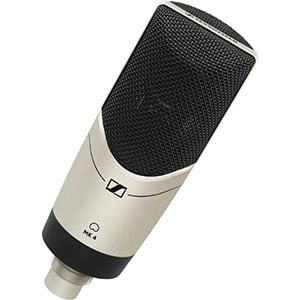 | Sennheiser MK4 Total of 4.73/5 | Hard to fault this no frills German-made condenser. | |
+ -  | Shure SM-27 Total of 4.55/5 | Easily one of the most reliable all purpose condenser microphones currently available. | |
+ -  | Audio-Technica AT4040 Total of 4.53/5 | A very reliable, consistent and refined large diaphragm design from Audio Technica. | |
+ -  | Audio-Technica AT2050 Total of 4.50/5 | No-nonsense, subtle design that brings consistent performance with plenty of additional versatility. | |
+ -  | Rode NT1 Total of 4.38/5 | A truly awesome model that brings the essence of that vintage sound. | |
+ -  | Shure BETA 87A Total of 4.47/5 | One of the most reliable and best performing live handheld condenser mics. |
Aston Microphones Origin
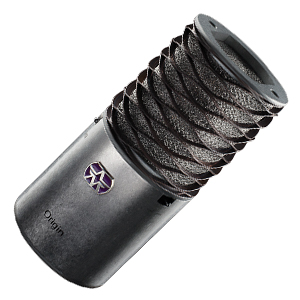
| Design: |  |
| Features: |  |
| Performance: |  |
| Value: |  |
UK-based mic brand Aston Microphones are responsible for producing some of the most impressive mics you can find, from high-end models down. The midrange Origin is proof of this!
Even at this price, this unique condenser microphone screams ‘boutique’, with an almost steampunk design and tumbled stainless steel build. The components and specs are equally as solid, leading to vocals that sound refined, warm and well balanced.
Undoubtedly, the Origin is one of the most unique condenser mics you can find for under $300. There’s more on this mic in the complete Aston Origin review.
Sennheiser MK4
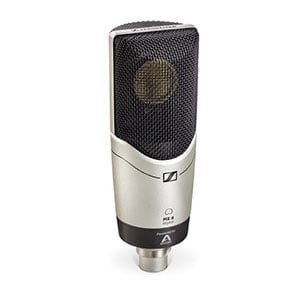
| Design: |  |
| Features: |  |
| Performance: |  |
| Value: |  |
A new addition to this chart is the MK4 from Sennheiser – an excellent all-rounder when it comes to midrange large diaphragm condensers.
Made in Germany, the minimalist design and overall build quality really is top notch. With a full metal silver chassis, side-address grille and considerable weight, it feels like a higher-end mic.
While it lacks a few features, and is restricted to a fixed cardioid polar pattern, the core performance is impressive and it delivers clean and relatively neutral vocals, making it ideal for serious studio recording. For more on the Sennheiser MK4, check out the full review.
Shure SM-27
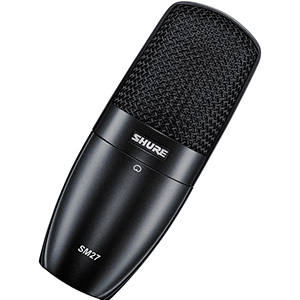
| Design: |  |
| Features: |  |
| Performance: |  |
| Value: |  |
Shure’s track record is pretty stellar when it comes to midrange condenser microphones in both handheld and studio models – the SM27 being a good demonstration of the latter.
As we point out in the complete SM27 review, it’s a simple but effective mic, sporting a quality build and stealthy all-black design.
It’s also a well-rounded all-purpose microphone that’s as good for vocals as it is aggressive instruments. This mic also shows off plenty of flexibility thanks to things like the three-position low-frequency filter, built-in pop filter, and an attenuator switch.
Audio-Technica AT4040
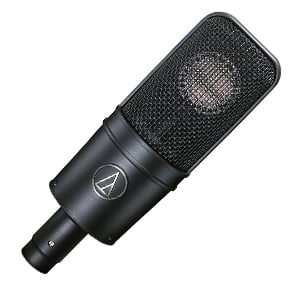
| Design: |  |
| Features: |  |
| Performance: |  |
| Value: |  |
The first Audio-Technica model to hit this list is the excellent all-rounder, the AT4040. This is a serious large-diaphragm condenser microphone that packs a whole lot of versatility.
Ultimately the design is quite basic, although the fact you can see the diaphragm through the wide grille mesh gives it more of a premium tint. The build quality – highlighted in the full AT4040 review – is very sturdy.
It also impresses specs-wise, with a high max SPL, an attenuation pad and a low-pass filter making this a versatile workhorse of a mic that feels like great value.
Audio-Technica AT2050
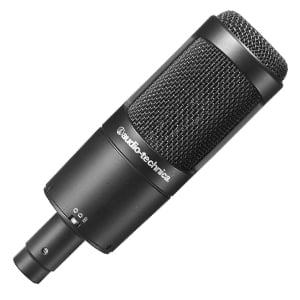
| Design: |  |
| Features: |  |
| Performance: |  |
| Value: |  |
Surprised to see another from Audio-Technica on this list? Don’t be – their range is huge and their condenser mics prove hard to ignore.
While the design is quite simple, the reason the AT2020 appears here is thanks to its impressive flexibility. Unlike some others on this chart, it features switchable polar patterns, allowing you to choose from standard cardioid, omnidirectional and figure-8 polar patterns.
The overall core performance for both vocals and instruments is excellent too – well worth checking out. Be sure to read more on the Audio-Technica AT2020 in the main review!
Rode NT1
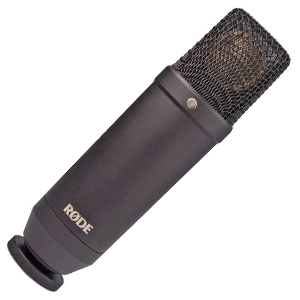
| Design: |  |
| Features: |  |
| Performance: |  |
| Value: |  |
On the face of it, the Rode NT1 is surprisingly simple – almost completely devoid of standard features! However, the sleek design and tank-like build is enough for this excellent side-address large-diaphragm condenser mic.
It’s under the hood where this mic really comes alive as it is home to Rode’s HF6 capsule along with excellent electronics – as we have outlined in the full review of the Rode NT1.
This all combines for an exceptional sound quality for a midrange studio mic, which is perfect for recording vocals, with a slight vintage tint to the sound.
Shure BETA 87A
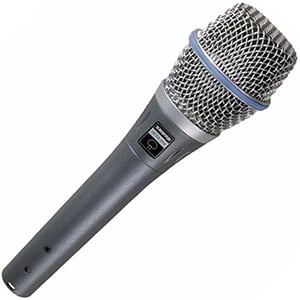
| Design: |  |
| Features: |  |
| Performance: |  |
| Value: |  |
Looking for a handheld condenser mic that will deliver studio-level quality with the versatility of a dynamic stage mic? At this price, you don’t have to look much further than Shure’s Beta 87A.
As we mention in the full breakdown of the Beta 87A this fixed supercardioid mic is a rugged, reliable and well-optimized piece of kit that has a lot to offer.
With a robust chassis, this mic is clearly geared towards live use, using an internally-suspended capsule and built-in pop filter to reduce unwanted noise. It delivers clear vocals that really cut through the mix. A solid choice for performers!
What to Expect From a $300 Condenser Mic?
When you start looking at condensers that cost north of the $200 price range, you are beginning to enter the midrange segment of the market – not yet premium, but well out of the entry-level range.
With this increased price comes increased expectations. You are allowed to demand improvements in several areas – after all, why would you pay an extra $100 if not to see a better microphone? In this section we will take a look at some of the improvements you can expect to see in a sub-$300 microphone.
More Brands
As with pretty much any industry out there – from cars to guitars – some brands cover specific portions of the market. For example, just like you wouldn’t see a Jasmine guitar in the premium acoustic guitar market, you would be more than surprised to see a Gibson acoustic anywhere near the budget range.
The same goes for condenser microphones. As we reach the $300 region, we begin to see more choice in brands, such as condenser offerings from Rode, Sennheiser, and Aston Microphones. This doesn’t necessarily mean that these newly available microphones are inherently better than their competition, but it is always good to have more choice.
Improved Design
In terms of aesthetics, some of the mics in this range are pretty standard – simple all-black no-nonsense outfits that do the job. However, some designs in this range are exceptional. They aren’t custom-built boutique mics, yet they possess several qualities of higher-end mics as manufacturers have more of a budget to play with. Expect everything from vintage looks to rustic tumbled steel chassis.
By ‘design’, we also mean build quality, because the mics in the under $300 market are built to last. This usually includes a heavy-duty all-metal chassis, a rock-solid grille, and components and electronics that are reliable and long-lasting. Plastic should be nowhere to be seen in this range!
Upgraded Hardware
It’s what is under the hood that ultimately dictates the performance of a microphone. Up until now, more affordable models have certainly shown some impressive components, which makes them capable of producing good quality vocal and instrument recordings. However, with a $300 condenser mic, you are looking at a new level of refinement when it comes to various components.
For example, diaphragms are much more sophisticated, preamps are better designed and electronics are more reliable. This is also the range where you start to see more integrated pop filters, internal shock mounts, and other advanced solutions that aren’t as common on affordable mics.
Better Performance
Of course, having better hardware as mentioned above means that the performance of these mics will improve. While sound is subjective, it would take an odd ear to believe that the mics in this price range don’t generally sound much higher in quality than those in the lower end of the market.
This quality is usually defined as being transparent and warm for both vocals and instrument recording. Transparency in a condenser microphone is important for compatibility. Each of us has a unique voice and having a transparent microphone means it will work well with whatever voice you throw at it – from a petite soprano to a death metal lead man.
Mics in this range are also less noisy than their lower-priced brothers, with the aforementioned internal shock mounts and pop filters, as well as more refined electronics, reducing self-noise.
Extra Features
Finally, we come to one of the most important reasons to invest in a midrange condenser mic – the features. This usually includes simple but very useful features, such as attenuation pads and various frequency filters, which can completely change the practical value of a microphone.
You will also find more choice when it comes to polar patterns. Instead of being restricted to a cardioid pattern, you will find more mics with switchable polar patterns, allowing you to move to an omnidirectional, figure-8 or supercardioid pattern. This isn’t necessary for all studio recording, but those wanting to record things like orchestras or choirs will appreciate the flexibility.
While these additional features may not define the core performance of the microphone, they certainly have an impact on its versatility.
The Final Word
As you can see, there are plenty of reasons why buying a $300 condenser microphone makes a lot of sense. This price range is still quite affordable for most people, while the build, features and performance are noticeably better than budget mics.
The models we have listed in our chart above are undoubtedly some of the best on the market at the moment, although don’t be afraid to do your own research – you may find something that suits your application better. We hope we have inspired you with our choices and wish you the best of luck in your hunt for the perfect condenser mic!



Reader Interactions